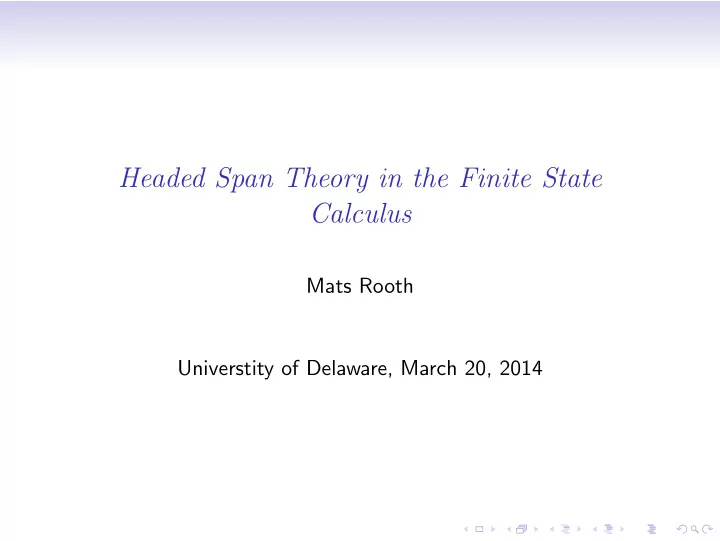

Headed Span Theory in the Finite State Calculus Mats Rooth Universtity of Delaware, March 20, 2014
OT derivations
Mawapa
Mawapa
Mawapa Nasal intervals/spans are marked with square brackets. m is always in a nasal span.
Mawapa p is always the head (marked with a preceding period) of an oral span (marked with round brakets).
Mawapa
Mawapa
Headed Span Theory Headed span theory in phonology is an account of the phonological substance that represents an autosegent such as a nasality feature as a labeled interval in a line, rather than as a vertex in a graph. The intervals (or spans) have distinguished head positions. J. McCarthy (2004), Headed Spans and Autosegmental Spreading.
Today’s Project Work out a detailed, computationally executable construction of span theory in the finite state calculus. This includes a construction the constraint families of headed span theory as operators. The finite state calculus is an extended mathematical language of regular expressions.
Idea 1: Labeled Brackets Use a string encoding of span representations, using labeled brackets. [ . mawa ]( . pa ) [NMn.N+Mn..NM.NM...NM.M][N-Mv.Mv..NM.M...NM.M] [N-Mg.Mg..NM.M...NM.M][N-Mv.Mv..NM.M...NM.NM] [N-Mo.N-Mo..NM.NM...NM.M][N-Mv.Mv..NM.M...NM.NM]
Labeled Brackets Start and end of [Nasal -] [N-Mo.N-Mo..NM.NM...NM.M][N-Mv.Mv..NM.M...NM.NM] Start and end of [Manner obstruent] [N-Mo.N-Mo..NM.NM...NM.M][N-Mv.Mv..NM.M...NM.NM] Start and end of [Manner vowel] [N-Mo.N-Mo..NM.NM...NM.M][N-Mv.Mv..NM.M...NM.NM]
Idea 2: Underlying representation in the same string and encoding Start and end of underlying [Nasal -] [N-Mo.N-Mo..NM.NM...NM.M][N-Mv.Mv..NM.M...NM.NM] Start and end of underlying [Manner obstruent] [N-Mo.N-Mo..NM.NM...NM.M][N-Mv.Mv..NM.M...NM.NM]
Encoding of a minimal timing unit 1. Feature spans that start here underlyingly, with values [N-Mo.N-Mo..NM.NM...NM.M] 2. Feature spans that start here on the surface, with values [N-Mo.N-Mo..NM.NM...NM.M]
Encoding: heads 4. Feature spans that are headed here underlyingly [N-Mo.N-Mo..NM.NM...NM.M] 5. Feature spans that are headed here on the surface [N-Mo.N-Mo..NM.NM...NM.M]
Encoding: ends of spans 8. Feature spans that end here underlyingly [N-Mo.N-Mo..NM.NM...NM.M] 9. Feature spans that end here on the surface [N-Mo.N-Mo..NM.NM...NM.M]
Idea 3: Finite state calculus The finite state calculus is a formal language of extended regular expressions. Define the syntax of phonological representations with a sequence of definitions. Feature blocks
Idea 3: Finite state calculus Left semi-segment
Finite state calculus The definitions are mathematical, but they can be interpreted computationally using a finite state programming language or toolkit. I use Xfst and Thrax.
Well-formed words Well-formed words are defined with a sequence of definitions. The first group define semi-segments (half segments) with properties such as starting and F span or heading an F span underlyingly or on the surface.
Well-formed words
Well-formed words
Well-formed underlying F-span
Well-formed word
Well-formed word A well-formed word is well-formed in each feature, underlyingly and on the surface.
Well-formed two-segment words There are a lot, because underlying and surface words are not correlated except (in this model) in length.
Idea 4: constraints as relations OT constraints are relations that insert violation marks.
SpHdLNaMinus SpHdLNaMinus inserts a violation mark in a locus that heads a [N,-] span and does not start it. This is the last part of the four candidates, after marking.
Idea 5: Algebraic optimization We want to optimize a set of candidates using a constraint. Optimization uses set difference and the relation LX ( x , y ) true iff x contains fewer violation marks than y . LX is definable in the finite state calculus. Here is the finite state machine that results from compilation. Pairs of strings for paths from state 0 to states 0 and 2 have equal numbers of stars. Paths from 0 to the final state 1 have more stars on the right.
Algebraic optimization We want to optimize a candidate set x with a constraint r . [ x ◦ r ] I x marked up using constraint r [ x ◦ r ◦ LX ] I Strings that have more marks than some candidate in [ x ◦ r ] I . [ x ◦ r ] I − [ x ◦ r ◦ LX ] I Subtract off sub-optimal candidates to obtain the optimal candidates. x ◦ r is the restriction of relation r to domain x , r ◦ r ′ is the composition of relations r and r ′ , and r I is the image of relation r . Algebraic optimization was introduced in Eisner (2001). Using it with LX gives classical OT optimization. It only works for generation–this finite state realization of classical OT does not allow us to map surface representations to underlying ones.
Example
Example
Idea 6: Constraint families as functions Constraint families are an organizing principle in OT phonology. Instead of an single constraint NoSpanNa, we have a family of no-span constraints NoSpan(F), where F is a feature attrubute.
Constraint families as functions
Constraint families as functions
Program for an OT derivation
Underlying unit segment An underlying unit segment for [F,X] starts F with value X, heads F, and ends F.
Underlying spelling for nasal problem To spell “f” underlyingly, specify a unit [N,-] span and a unit [M,f] span.
Underlying spelling for nasal problem A sequence of conditionals spells various underlying letters, e.g. U(f).
McCarthy conditional Test is a McCarthy conditional in the finite state calculus. Test(X,Y,Z) is Y if X is empty, otherwise Z.
Truth values Empty language is used as False, and universal language (or any non-empty language) is used as True.
Gen
Partial spreading
Partial spreading In shell: xfst -q -f mawapa.fst xfst -q -f mawapa2.fst
Summary 1. Labeled brackets as representation of spans 2. Underlying and surface representations in one string 3. Build representations a sequence of definitions in finite state calculus 4. Constraints as relations that insert violation marks 5. Algebraic optimization 6. Constraint families as functions 7. Finite state program calculates directly with with candidate sets and constraints. 8. Encoding of transparent segments using embedded exception spans.
Recommend
More recommend